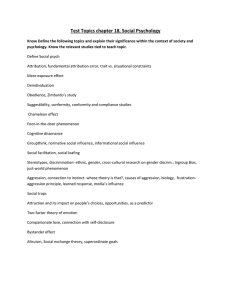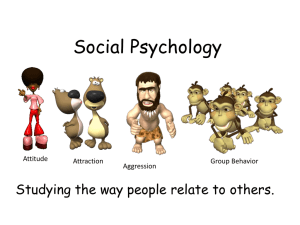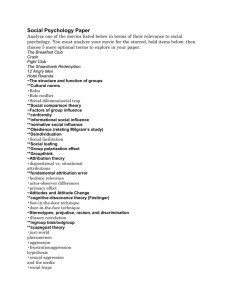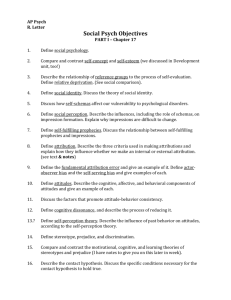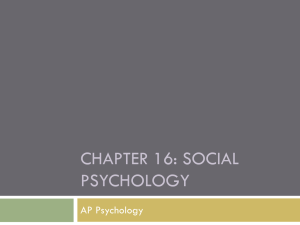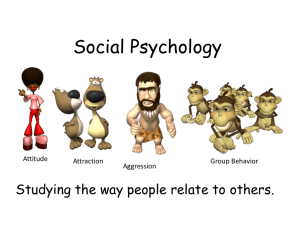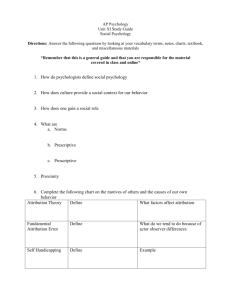Social Psychology
advertisement
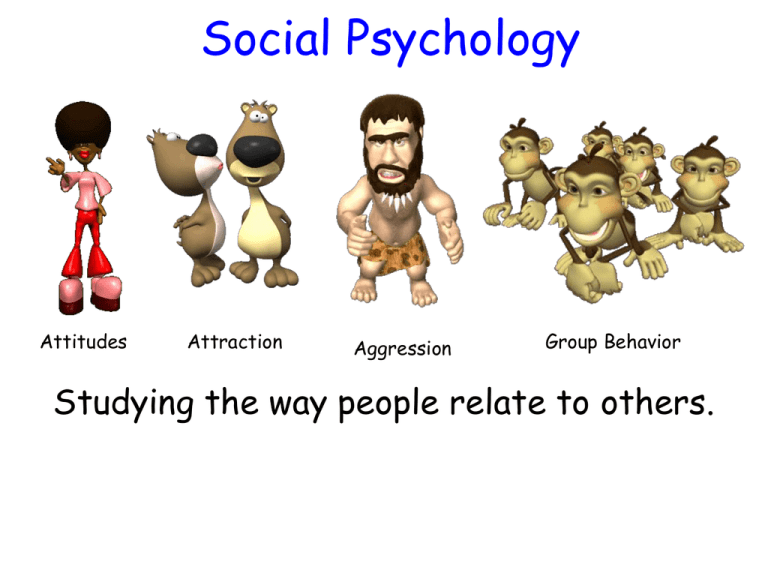
Social Psychology Attitudes Attraction Aggression Group Behavior Studying the way people relate to others. Attribution Theory • Tries to explain how people determine the cause of the behavior they observe. It is either a…. • Situational Attribution (external factors) • Dispositional Attribution (internal or personal factors) And • Stable Attribution (unchanging factors) • Unstable Attribution (temporary factors) Social Cognition and Person Perception The Human Experiment 30 Fundamental Attribution Error • We tend to overestimate the role of dispositional factors and underestimate the impact of the situation. Individualistic cultures are more prone to this. False Consensus Effect Self-Serving Bias When you start a romance, you assume that they agree with your world views…. honeymoon period. If you win it is because you are awesome…if you lose, it must have been the coach or weather or…. Using Social Psychology Theory Explain Why? The Effects of Attribution • Social Effects • Political Effects • Workplace Effects Attitudes • A set of beliefs and feelings. • Advertising is ALL based on attitude formation. • Mere Exposure Effect. • Central Route to Persuasion vs. Peripheral Route to Persuasion. How does attitude change occur? • Persuasion can occur in either of two ways: • 1. Central route to persuasion. • 2. Peripheral route to persuasion. 1.) The Central Route to Persuasion • Involves being persuaded by the arguments or the content of the message. • For example, after hearing a political debate you may decide to vote for a candidate because you find the candidate’s views and arguments very convincing. 2.) The Peripheral Route to Persuasion • Involves being persuaded in a manner that is NOT based on the arguments or the message content (only superficial things). • For example, after reading a political debate you may decide to vote for a candidate because you like the sound of the person's voice, or the person went to the same university as you did. A tale of two routes • Peripheral route relies on heuristic processing: mental shortcuts (“rules of thumb”). • -low cognitive effort (e.g., “experts can be trusted”) • We tend to use the central route when: – We are knowledgeable about the subject. – Issue is important to us. Attitude and Behavior You have a belief that cheating on tests is bad. But you cheat on a test!!! • Do attitudes tell us about someone’s behavior? • LaPiere’s Chinese Couple / Hotel Study (1934). Cognitive Dissonance Theory • People want to have consistent attitudes and behaviors….when they are not consistent with each other they experience dissonance The teacher was (unpleasant tension). really bad so in that class it is OK. • Usually they will change their attitude. Actions Can Affect Attitudes • Foot-in-the-door phenomenon (small to larger request). • Door-in-the-face phenomenon (large to smaller request). • Norms of reciprocity. The Power of the Situation: Roles, Conformity and Obedience Zimbardo’s Prison Study • Showed how we can often become the roles we are given. • Philip Zimbardo has students at Stanford U. play the roles of prisoner and prison guards in the basement of psychology building. • They were given uniforms and numbers for each prisoner. • What do you think happened? • Do you remember the Abu Ghraib Prison photos from Iraq? Abu Ghraib Prison Photos Conformity Studies • Adjusting one’s behavior or thinking to coincide with a group standard. Soloman Asch’s Study of Conformity Asch’s Results • About 1/3 of the participants conformed when in a group. • When alone they erred less than 1% of the time. Conformity strengthens when: • The group is unanimous. • The group is at least three people. • One admires the group’s status. • One has made no prior commitment. • One is made to feel incompetent or insecure. Reasons for Conforming • Normative social influence: you want to gain approval or avoid disapproval. • Informational social influence: you are willing to accept other’s opinions. Milgram’s Study Of Obedience The Human Experiment 34 Results of the Milgram Study What did we learn from Milgram? • Ordinary people can do shocking things! • Ethical issues… • Would not have received approval from today’s IRB (Internal Review Board). What did we learn from Milgram? • People were more obedient when: • 1. The authority figure was in the room. • 2. When they felt the experiment was part of a prestigious institution. • 3. The learner was not in sight. How do groups affect our behavior? Social Facilitation Theory • If you are really good at something…or it is an easy task…you will perform BETTER in front of a group. • If it is a difficult task or you are not very good at it…you will perform WORSE in front of a group (social impairment). Group Dynamics Social Loafing • Tendency for people in a group to exert less effort when pooling efforts toward a common goal (than if they were individually accountable). Deindividuation • People get swept up in a group and lose sense of self. • Feel anonymous and aroused. • Explains rioting behaviors. Group Polarization • Groups tend to make more extreme decisions than the individual. The more you are around people who think like you … the stronger your beliefs get. Groupthink • Group members suppress their reservations about the ideas supported by the group. • They are more concerned with group harmony. • Worse in highly cohesive groups. The Power of Individuals • Minority Influence – the power of one or two individuals to sway the majority (like Rosa Parks). • They are most successful when they express their views consistently. Social Relations Attraction Conflict and Prejudice Altruism and Peacemaking How do we relate to others? Aggression Stereotypes, Prejudice, and Discrimination Stereotype: • Overgeneralized idea about a group of people. • Stereotype Treat Prejudice: • Undeserved (usually negative) attitude towards a group of people. Ethnocentrism is an example of a prejudice. Discrimination: • An action based on a prejudice (Individual vs. Institutional). Color Blind or Color Brave? Is it just race? NO! • Palestinians and Jews • N. Cal vs. S. Cal • Men and Women But women have some things going for them like…… Which person would you want to have a long term relationship with? How does prejudice occur? Just World Phenomenon • • In one popular study female and male subjects were told two versions of a story about an interaction between a woman and a man. Both variations were exactly the same, except at the very end the man raped the woman in one and in the other he proposed marriage. In both conditions, both female and male subjects viewed the woman's (identical) actions as inevitably leading to the (very different) results. In-Group versus Out-Groups. • In-Group Bias Scapegoat Theory Combating Prejudice Contact Theory • Contact between hostile groups will reduce animosity if they are made to work towards a superordinate goal (common shared goal). • Sherif’s camp study Prejudices can often lead to a…. Self-Fulfilling Prophecy: • A prediction that causes itself to be true. • Rosenthal and Jacobson’s “Pygmalion Effect” in the classroom experiment… “Pygmalion Effect” • In this experiment, Rosenthal predicted that, when given the information that certain students had higher IQ’s than others, teachers may unconsciously behave in ways that facilitate and encourage the students' success. Conflict ($1 Auction Activity) • A perceived incompatibility of actions, goals, or ideas. • Social Trap: when people pursue their own self interests and it leads to mutually destructive behaviors. Aggression • Any physical or verbal behavior intended to hurt or destroy. • In the U.S. we are MUCH more likely to be murdered compared to most other developed nations. The Biology of Aggression • Genetics • Biochemical • Neural Influences Psychology of Aggression Two types of aggression: 1. Instrumental Aggression 2. Hostile Aggression Theories of Aggression: Bandura’s Modeling Frustration-Aggression Hypothesis Other Factors and Aggression Can we learn to be aggressive or gentle? They can be learned but…. Once learned they are difficult to change. Aggression and TV Watches = • By the time you are 18, you spend more time in front of TV than in school. •2/3 of all homes have 3 or more sets and an average 51 hours a week of TV. •By the time a child finishes elementary school they have witnessed 8000 murders and 100,000 other acts of violence on TV. •Over half of all deaths do NOT show the victim's pain. •As TV watching has grown exponentially, so has violent behavior - a strong positive correlation. •How do you think TV has effected sexual aggression? Attraction 3 Factors of Attraction: 1.) Proximity • Geographic nearness Mere exposure effect: • Repeated exposure to something breeds liking. • Taiwanese Letters. 2.) Similarity • Paula Abdul was wrong- opposites do NOT attract. • Birds of the same feather do flock together. • Similarity breeds content. 3.) Physical Attractiveness The Hotty Factor • Physical attractiveness predicts dating frequency (hotties date more). • They are perceived as healthier, happier, more sensitive and successful. What is beauty? • Some people say beauty is facial symmetry. Beauty and Culture • Obesity is so revered among Mauritania's white Moor Arab population that the young girls are sometimes force-fed to obtain a weight the government has described as "life-threatening." • Of course, here in the U.S. we prefer hard, thin bodies. Are these cultures really that different? LOVE • Passionate Love: an aroused state of INTENSE positive absorption of another. • Companionate Love: the deep affectionate attachment we feel for those with whom our lives are intertwined. What makes companionate love work? • Equity • Self-disclosure Altruism: Unselfish regard for the welfare of others. • Kitty Genovese case in N.Y. showed none of this. Why? Bystander Effect: • Tendency for any given bystander to be less likely to give aid if other bystanders are present. In general…the more people around…the less chance of help… because of a … • Diffusion of Responsibility: • They figure that someone else will do something. Norms for Helping • Social Exchange Theory – social behavior is an exchange process, the aim of which is to maximize benefits and minimize costs. • Reciprocity Norm – an expectation that people will help those who have helped them. • Social-responsibility norm – expectation that people will help those dependent upon them. Peacemaking • Give people superordinate (shared) goals that can only be achieved through cooperation. • Win-Win situations through mediation. • GRIT (Graduated and Reciprocated Initiatives in Tension Reduction) – a strategy designed to decrease international tensions.
